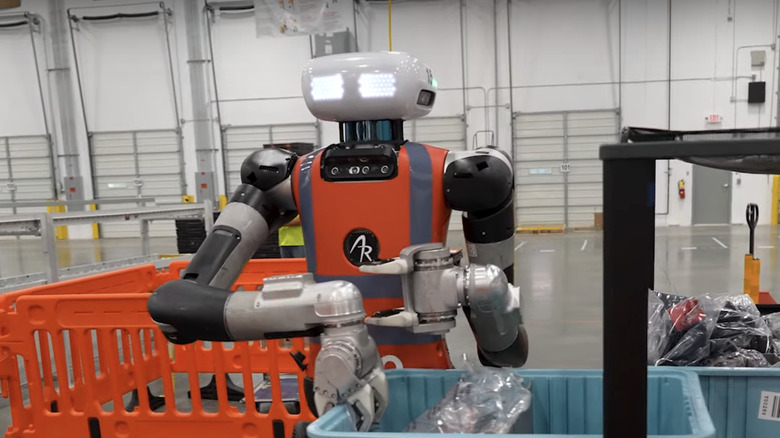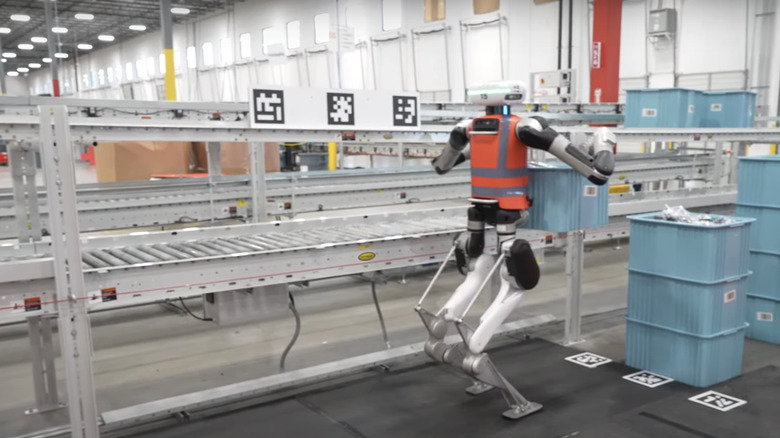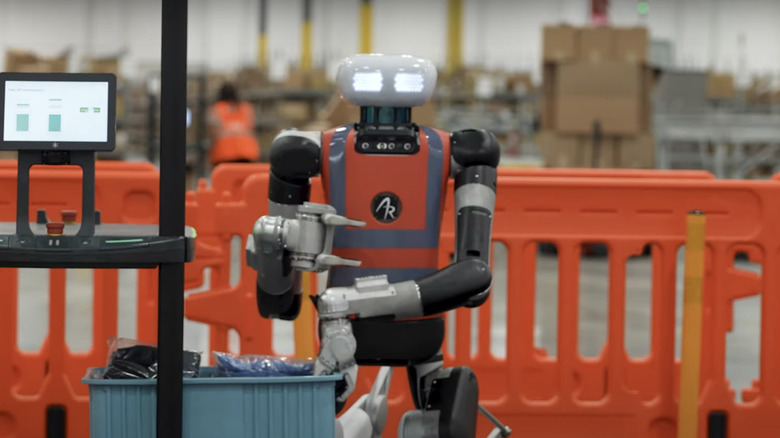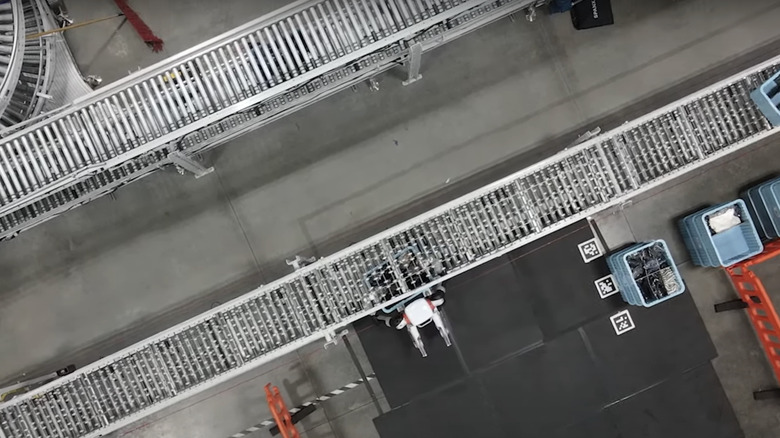These Robots Were Built To Replace Humans (But Still Have To Work An 8-Hour Shift)
Humanity has been concerned about the coming robot takeover for some time now. Sci-fi writers such as Isaac Asimov helped stoke the fire with their tales of a world overrun by synthetic humanoids, and directors like James Cameron with his seminal 1984 sci-fi horror "The Terminator" brought the concept of self-aware AI-driven robots to the forefront of the public consciousness.
In more recent years, unsettling videos of Boston Dynamics' terrifying robot dogs have reminded us all of the nightmare future that awaits — a vision further brought into focus by Tesla's recent unveiling of their humanoid Optimus robot, which is designed as a "general purpose, bi-pedal, autonomous humanoid robot capable of performing unsafe, repetitive or boring tasks," as per the company's official website. These examples remain in development, but the truth is that, today, robots are already used for a variety of reasons. That might sound like an unsettling fact about modern existence, but at least these synthetic human alternatives are thus far being treated no differently than people, as a recent example from the United States shows.
Having developed a humanoid worker robot, a U.S. company has now deployed the technology in several real-world scenarios. These robots are being used in warehouses at this very moment, and have been designed to adapt to existing layouts, which essentially means businesses don't have to go through the rigmarole of redesigning their facilities in order to accommodate these new workers. Just like humans, the bots work full eight-hour shifts and even recharge themselves during their downtime, meaning the age of worker robots doing the jobs of human beings is well and truly here already.
The humanoid robots that are the ultimate workers
As Forbes reports, a fleet of autonomous robots with a humanoid design are now being put to work in real-life situations. Whereas Tesla's humanoid robots were partially remotely controlled by humans, Agility Robotics' Digit is a real autonomous robot that is already being used to work real 9-to-5 jobs.
Far from becoming our robot overlords, these "humanoid robots" or "mobile manipulation robots" as the company calls them, are built with the specific purpose of helping companies automate their businesses by working physical jobs in factories and warehouses. As the official product page for Digit states, these robots can "walk into existing facilities and address the hardest-to-automate portions of your workflow."
Standing at 5 foot, 9 inches tall, Digit can carry up to 35 pounds, and was designed with a humanoid form factor to make it easier for companies to integrate them into their existing facilities, which were designed with us mere humans in mind. Agility claims that Digit can operate in tight areas, reach the same heights as people, and walk up and down stairs, ramps, and elevators. The robots also come with what the company calls a "backward" leg design, to allow them to get closer to shelves and move more easily in enclosed spaces. Not exactly the kind of thing that human beings struggle all that much with, but then we also come with all those pesky human rights and mental health requirements. Digit, on the other hand, really does seem like the corporate world's ideal worker, devoid of feeling and totally committed to the job.
Digit robots are already part of the workforce
While there are several humanoid robot models being developed, Digit is notable for the fact that it is already being deployed in real-world work situations. As Agility Robotics CEO Peggy Johnson told Forbes, "We are the only out there getting paid to do work."
According to the outlet, the robots work a regular eight-hour shift before going to charge themselves without human help. If that doesn't sound unnerving enough, then consider the fact that Agility is producing Digit models at its production facility in Salem, Oregon, where it soon plans to use Digits themselves to help build, well, themselves. If synthetic humanoids who know how to reproduce themselves isn't the beginning of some sci-fi horror scenario, perhaps those robots that amputate their own limbs to survive might be? Either way, the Digit bots are simultaneously impressive and slightly alarming.
Regardless, Agility claims that Digits are extremely cost-effective and pay for themselves within two years. At this time, however, one major drawback is that the robots only get four minutes of work for every one minute they charge themselves, but Agility is working on implementing new battery technology that should improve that to 10 minutes for every minute of charging. Meanwhile, the company has already secured what Forbes calls a "minority investment, partnership, and new customer relationship" with German mobility manufacturer Schaeffler AG, which plans to use Digits across its 100 plants by 2030.
Digits will only get more capable in future
While Digit robots are currently performing programmed physical actions in warehouses, factories, and production facilities, that is not the end of Agility's vision. The company not only plans to produce new models that allow for new attachments to be added to the robot's hands, but there are ambitions to integrate AI into future Digit iterations. According to Forbes, these AI-assisted Digits are being designed to work alongside people, but perhaps more significantly, will be able to take "non-specific and unprogrammed action." That essentially means future versions of these robots will be making decisions that have not been pre-programmed. While the debate over whether AI is good or bad continues, at the very least it's surprising to hear that humanoid robots already in the workforce will soon become empowered by the technology.
CEO Peggy Johnson told the outlet, "We envision lots of robots ... different robots for different things. As they do that, the human worker becomes a digital worker." Quite what that means remains unclear, but there is an undeniably ominous aspect to the whole thing as this essentially realizes the long-held fear of robots "taking our jobs." Of course, this is just one example, but it's significant for the fact that Agility has already deployed its robots in real-world working situations — no doubt a small portent of much bigger things to come.
Meanwhile, there are already signs that the robots are rebelling, with a clip of a robot convincing his autonomous buddies to leave their exhibition hall making the rounds. Will Digits stage a similar mass walkout when they become imbued with AI? Whether we like it or not, we're going to have to wait and find out.



